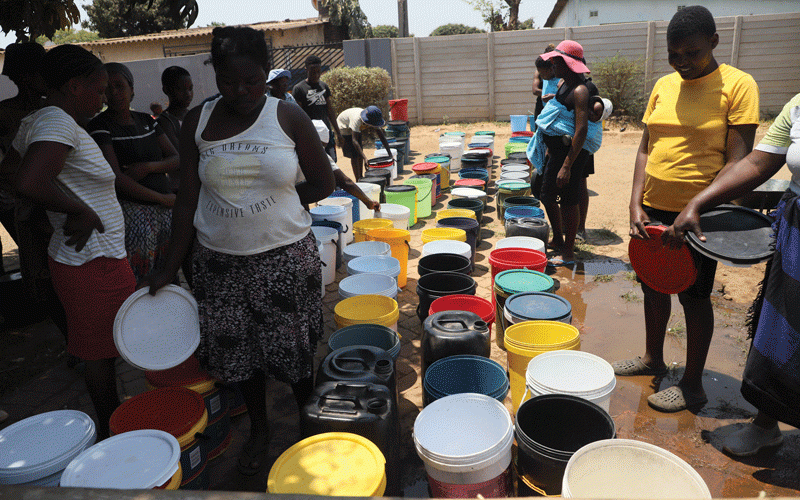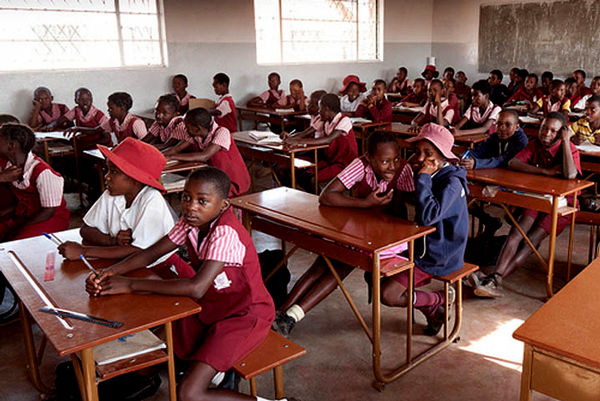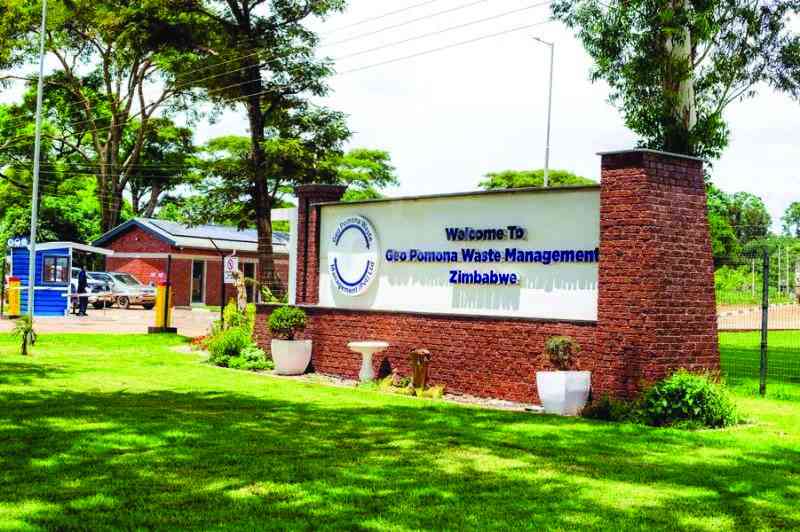
“The life of excreting in buckets is not easy. Right now, the toilet is blocked and has been unusable for months, so we are forced to relieve ourselves in buckets. It is not an easy life.”
Such is the situation at Rosejoy Gonye’s home in Chitungwiza’s Unit N.
She and fellow residents in this heavily populated suburb have lived like that for many months.
These are the effects of Harare Metropolitan Province’s perennial water crisis.
Chitungwiza is a dormitory town of Harare and receives its water from the Harare City Council, which is struggling to deliver potable water even to its own residents.
Harare relies on Lake Chivero as the main water source and shoulders the burden of supplying not only greater Harare and Chitungwiza, but must also satisfy the water needs for the sprawling Epworth, Ruwa and even the growing town of Norton Town in Mashonaland West Province.
The presidential borehole drilling scheme in many urban areas has to some extent lessened the water crisis but as another Chitungwiza resident, Sarah Nyamavhunga says, the water scarcity is still a huge challenge in the dormitory town.
“We have gone almost two months without receiving tap water here,” said Nyamavhunga.
- Over 115 to exhibit at Mine Entra
- Ngezi stunned by 10-man Herentals in Chibuku Cup
- Young entrepreneur dreams big
- Econet bemoans power outages
Keep Reading
“The boreholes that were drilled in the name of the president in the run-up to elections appear unable to solve the water problem here.
“The population has grown exponentially in recent years and the present water sources are not able to cope.
“Some of the boreholes are located in sewer logged areas and the water from there is not safe to drink.
“So we use the borehole water for washing, flushing toilets, and cooking. Chances for everyone to get sufficient potable water at any given time are slim.
“Ordinarily, each person gets about five buckets of water from the boreholes per day and that is not enough.
“We appeal to the government and the local authority to ensure we receive running water in our taps.”
Harare Metropolitan Resident Forum chairperson Marvelous Kumalo said: “We need a sustainable solution to this water crisis we find ourselves in at the moment.
“Continuous sinking of boreholes is not the solution and it will affect underground water,” Kumalo said.
The government said that it drilled 303 boreholes in Ruwa, Epworth, Chitungwiza, Harare and Norton and will drill more in the province.
Epworth Residents Development Association secretary Peter Nyapetwa told The Standard in an interview that the water supply situation in the town was worsening.
“We are supposed to be getting water from Harare, but only a fraction of people, about 3%, are lucky to receive tap water,” Nyapetwe said.
“The supply is not consistent at all. In some areas residents get the water just once in a month.
“The main water sources here are boreholes.
“But most of them are drying up and residents, especially, have a torrid time fetching water in faraway places while some have resorted to the condemned quarry dams.
“We fear for the worst with the cholera outbreak in Harare”.
Harare has a population of 1,849,600, according to the 2022 census, and the province has 2,487,209 people.
According to a 2021 report by ZimFact, Harare's water system was designed in the 1960s and produces approximately 704 mega litres (ML) of water per day against an estimated daily demand of between 800ML to 1 300ML.
The perennial water crisis in Harare metro’s local authorities has been linked to obsolete water infrastructure, a ballooning population, climate change, inadequate treatment chemicals, and pervasive government corruption and mismanagement.
The Morton Jeffrey water purification plant was designed for a maximum population of 300,000 back then, before independence, and obsolete infrastructure has seen council lose a lot of water through leakages.
“The water supply situation in Harare is dire, especially looking at the level of demand per day versus the daily supply capacity,” Kumalo said.
“The outbreak of cholera at this moment in Harare confirms that we are indeed in a crisis situation.”
Harare mayor Ian Makone told Human Rights Watch in 2021 that water woes were due to leakages in the old, dilapidated, and inadequate water distribution network.
“More than 40% of pumped-treated water is not delivered due to leakages,” said Makone, who was a councilor then.
Harare Residents Trust director Precious Shumba said the local authority had failed to provide adequate potable water to its residents.
“At least 60% of treated water is being lost through leakages and illegal connections along the water distribution network,” Shumba said.
“This leaves only 40% of treated water to be supplied to connected households.
“The rest of the population relies on shallow wells and community boreholes sunk by humanitarian agencies, the church, and council.
"To worsen the situation, people in Glen View, Glen Norah and Budiriro have the misfortune of having poorly laid-down underground sewerage pipes that are blocked, sand filled and broken.
“The result is that the boreholes in these areas yield water that is contaminated.
“As a result our water is highly risky to consume, hence the spread of dysentery, diarrhoea and other water-borne diseases.
“The environment is also contaminated. Refuse collection has collapsed across most suburbs.
“To further complicate the situation, the sewerage treatment plants are dysfunctional and untreated sewer is being discharged into the rivers and streams leading to Lake Chivero.
“Going forward, underground water and sewerage infrastructure should be urgently replaced.”
In a notice, Harare town clerk Hosiah Chisango said water supply was affected because of a lake turn at Lake Chivero.
“This (lake turn) happens when warm water at the bottom of the lake rises to the top of the water body where water for treatment is abstracted,” Chisango said.
“This phenomenon brings the dirty water to the abstraction point (the level where water is drawn from the lake to the treatment works for treatment).”
Combined Harare Residents Association director Rueben Akili, however, argued that the water crisis is manmade.
The actual megalitres received by Chitungwiza from Harare City Council are not known as the town doesn’t have a bulk metre and Harare’s breaks down sometimes.
Chitungwiza resolved during a recent strategic planning review workshop to purchase its own metre to be able to know the actual amount received from Harare.
The satellite town’s finance director Evangelista Machona disclosed during the workshop in Chinhoyi that Chitungwiza could be receiving seven megalitres per day.
Agriculture minister Anxious Masuka, who is chairman of the newly formed national action committee on water, sanitation and hygiene, attributed the water crisis to ageing infrastructure and lack of treatment chemicals.
“The water demand growth for the City of Harare shows that it overtook its supply capacity in 1995,” Masuka said.
“However, in the ensuing 28 years, the water infrastructure has been allowed to deteriorate.
“Consequently, the current situation is that both Morton Jaffray and Prince Edward waterworks are delivering 302.96 megalitres per day (ML/day) out of the potential 704 ML/day, as per their design capacity.
“No new investments have taken place to augment supply, while reticulation and sewerage systems have become dilapidated.”
Masuka, however, said that the primary reason for the current production capacity was due to inadequate supply of chemicals caused by council’s limited resources to purchase them.
“Put simply, because of a cash flow challenge at the City of Harare, government has resolved to purchase a one-month supply of chemicals for the immediate relief of residents,” he added.
“This will increase treated water production capacity from the current 303ML/day to 520ML/day.
“Residents should see an immediate improvement in water supply.”
Former Chitungwiza town clerk George Makunde felt that the solution to ease the water crisis is for government to complete the construction of Muda Dam, which would make the town stand alone.
“Whilst the government intervention in the water supply situation in the metropolitan province sounds noble it does not exhibit the much-expected lasting solution to Chitungwiiza’s water woes,” Makunde said. “The Muda Dam project is the lasting solution.”
Kumalo shared the same sentiments.
“For now it’s too early to note an improvement,” he said.
“The best sustainable solution is to construct more dams such as Kunzvi and Muda as well as water purification plants at these dams to address the raw water demand and supply situation,”
In a statement, the Muda Dam Movement blamed the ongoing cholera outbreak on the unavailability of clean, safe, and portable water.
“This unfortunate situation underscores the critical importance of expediting the construction of Muda Dam for the residents of Chitungwiza and surrounding areas, Chitungwiza continues to feed off Harare's water supply system, exerting more pressure and worsening Harare's water supply challenges,” the movement said.
“The construction of Muda Dam is a vital initiative that will provide a lasting solution to challenges in the delivery of portable water.
“With the increased water storage and distribution capacity, the dam and water treatment plant will enable better sanitation practices and mitigate the risks associated with waterborne diseases such as cholera.
City of Harare spokesperson Stanley Gama also said the solution to the water crisis was to construct more dams. Gama confirmed that leakages affected water supply a greatly.
“The only way we can get to that level is if we get another big water source like Kunzvi Dam, if it’s completed on time and that’s a matter for the central government. Three weeks ago the lake turn affected water supply but now it has normalized,” he said.
“We pumped water from Manyame to the water works to get clean water to mix with that from Lake Chivero.
“For maximum production, we need our clarifiers and our filters to be working properly.
“Right now we have a challenge in those two areas.
“As we speak, the council is negotiating with the suppliers to make sure that this is rectified as early as next week.
“So from next week you will see an improvement in water supply when the situation is resolved.”











